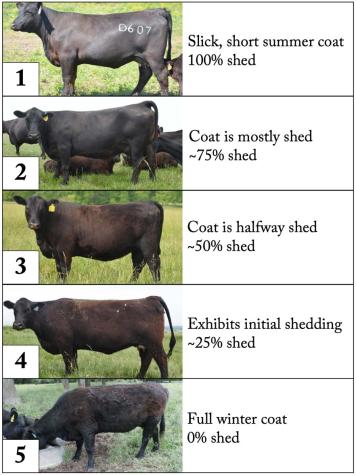COLUMBIA, Mo. – Selecting for cattle with heat tolerance can improve a producer’s profitability. An updated University of Missouri Extension publication, “Hair Shedding Scores: A Tool To Select Heat Tolerant Cattle,” explains how to score for hair shedding and seek lower scores for better heat tolerance.
The publication is available for free download at extension.missouri.edu/publications/g2014.
“Responsible beef breeding requires matching cattle genetics to the production environment,” said Jamie Courter, MU Extension state beef genetics specialist. “This is necessary for profitability, animal well-being and improved environmental impact. Cattle well-suited to their environment are more profitable. Not only are well-adapted cattle more productive, but they also require fewer inputs and interventions.”
One of the greatest environmental challenges for beef producers in many parts of the U.S. is heat stress, she said. This is especially true in the Southeast, where humidity intensifies the high temperatures with which cattle must cope to remain comfortable and productive.
“Selecting cattle that appropriately cope with heat stress is a major piece of sustainable beef production,” she said. It is estimated that cattle suffering from fescue toxicosis and heat stress alone costs the beef industry more than a billion dollars a year.
The publication, based on research by Jared Decker, MU associate professor of animal sciences, details the tools available to breed cattle adapted to heat stress.
Two new MU Extension publications prepared by Courter provide more detail:
In “How To Use the Hair Shedding Guide” (extension.missouri.edu/publications/g2041), producers can learn how best to assess their cattle for this important trait.
“Hair Shedding Scores: More Than Heat Stress” (extension.missouri.edu/publications/g2049) looks at the relationship between hair shedding and the animal’s ability to sense and respond to its environment, particularly the length of daylight.
“The animal’s ability to sense the day length is having a big impact on shedding,” Decker said. “We think there may be something to do with the eye, since that’s how mammals sense light.”
Research has also discovered genetic associations between hair shedding and functions related to metabolism. It is anticipated that hair shedding scores could be used in conjunction with body condition scores to assess the nutritional stress of the herd, said Courter.
“Therefore, hair shedding may also indicate an animal’s overall nutritional plane, thus helping to inform management decisions,” she said.
Later hair shedding (higher scores) indicates increased nutritional demands; this could be used to identify animals who would benefit from additional supplemental feed heading into spring and summer, Courter said.
This makes the hair shedding tool important to cattle producers all across the United States, she said.
Chart
A Tool to Select Heat Tolerant Cattle
From the MU Extension publication 'Hair Shedding Scores: A Tool to Select Heat Tolerant Cattle.'
Writer: Julie Harker
